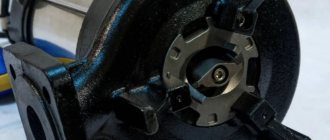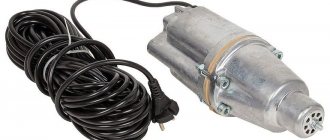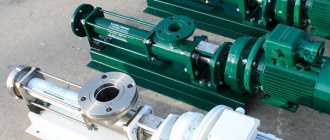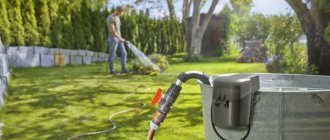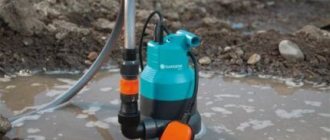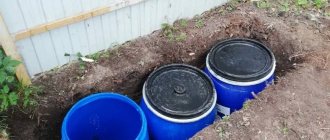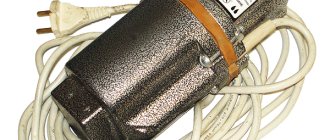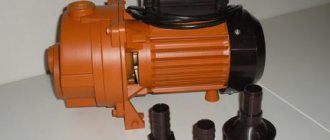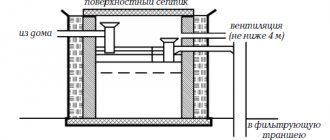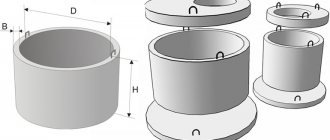In suburban areas without a central water supply, when organizing gardening and vegetable gardening, significant difficulties arise associated with watering plants. Typically, amateur gardeners fill large-volume containers with water from any suitable source, and then supply water to the beds using a bucket, watering can, and the most advanced - a pump for irrigation from a manual or electromechanical barrel.
It should be noted that an electric pump for watering a garden from a barrel can be submersible or surface mounted; the average cost of the most budget vibration pump is 1,300 rubles, which is cheaper or comparable to many manual models. Therefore, it is rational to buy and use an electric water pump for irrigation, choosing one of a wide range of models of domestic and foreign production in accordance with the required parameters and your financial capabilities. Read a separate article about hand pumps for water.
Preparing to water the area from a barrel
Criterias of choice
It should be noted right away that pumping equipment is determined by its technical characteristics. Namely: power, productivity, pressure. But there are also so-called operational characteristics that are directly related to technical ones:
- distance from the barrel to the farthest watering point;
- if the terrain on a summer cottage is uneven, then the height of the difference in the territory;
- the time during which the pump will be in operation;
- area for green spaces that require watering, and it is necessary to take into account what type of irrigation will be used: rain, drip or root irrigation.
Let's look at each technical characteristic separately and show how to make the right choice using simple mathematical calculations.
Performance calculation
Any technical device or equipment is equipped with a passport, which indicates its technical characteristics. The manufacturer installs metal plates on the pumps, where all unit parameters are also indicated. So, the pump performance has a unit of measurement: m/h, or l/min.
Pump performance is measured in l/min Source fontan.org.ua
Why is this indicator needed? For example, you need to water an area of 10x20 m, that is, an area of 200 m². It is believed that 1 m² of green space requires 3-5 liters of water for irrigation. Accordingly, if the irrigated area is 200 m², then for its moistening it is necessary to allocate: 200x5 = 1000 liters or 1 m³. This means that you need to select an irrigation pump with exactly this performance.
But here another question arises, which concerns time. That is, over what time period this volume of water will be poured onto the beds or under the trees. It all depends on what suits the summer resident. That is, it can be one day or one hour. For example, if you choose a pump with a capacity of 50 l/min, then 50 l of species will flow from the unit in one minute. It turns out that in 20 minutes the pumping unit will throw out 1000 liters, which is what you need.
You need to choose the right pump: strong watering or a small fountain Source hgcdn82.azureedge.net
Calculation of pressure
What does pressure mean? This is the height or distance of water supply, measured in meters, at the end point of which neither the pressure nor the productivity decreases. It should be noted that height, that is, vertical feed, and horizontal feed have different meanings. And there is a certain ratio between them - it is 1:10. That is, the vertical pressure is 10 times less than the horizontal one. For example, if the passport indicates that the pressure is 10 m, then this is its vertical value. This means that the unit will supply water horizontally over a distance of 100 m.
Now about the choice. Another example to understand what we are talking about. If the barrel is buried in the ground to a depth of 1.5 m, and the length of the watered bed is 35 m, then first of all it is necessary to indicate that the first parameter is the net vertical pressure, and the second should be measured ten times less, because it is horizontal . Accordingly, the required pump pressure is: 1.5 + 3.5 = 5 m. But here it is necessary to take into account the so-called losses along the path of water movement. This includes turns and bends of the hose, in which up to 20% of the pressure is lost. This means that to the resulting value of 5 m you need to add 35 x 0.2 = 7 m. The result is 5 + 7 = 12 m. Experts recommend adding another 10% here, so to speak, about the smell. Final result: 13.2 m. And this is the minimum figure.
The further the irrigation site is from the water source, the greater the pressure should be Source sadovij-pomoshnik.ru
See also: Catalog of country house projects
Power
With this characteristic everything is quite simple. Everything will depend on what type of irrigation a pump for supplying water from a container is required for: rain or drip. In the first case, a powerful unit is needed, in the second, a low-power one.
Installation
To install the irrigation system you will need:
- irrigation pump;
- barrel;
- flexible hose of sufficient length;
- taps and fittings;
- watering can or sprinkler.
The installation technology requires the following steps:
- Installation of a storage tank. Depending on the type of pump and irrigation system, the tank is installed on a hill, at ground level, or below ground level. A tank for a drip heating system is installed on a hill. A tank for an external pump is placed in the ground. A reservoir for a submersible pump is installed at ground level.
- A pump with the appropriate power for the irrigation system is installed.
- To regulate the filling of the tank, a float sensor is installed in it, which turns on the pump when the tank is empty and turns off when it is full. If the pump is connected to the water supply system, it cannot be turned off. In this case, the float regulates the operation of the valve, which closes when filling and opens when the tank is empty.
- Pipe distribution for the irrigation system is installed using fittings and taps, or flexible hoses are connected for manual watering.
Types of tank irrigation pumps
So, having understood the characteristics of pumping units and the criteria for their selection, we move directly to the question of which pumps for irrigation from containers are on the market.
Superficial
This type of pumping equipment received its name only because its installation location is next to the water tank. That is, it itself does not come into contact with the water - it does not sink into it, that is, it is located on the surface.
Water intake is carried out using a hose, which at one end is connected to a pump, the second is put into a barrel or other container. And it doesn’t matter where the pump is installed. That is, above the water level, below or at the same level.
Surface irrigation pump Source pbs.twimg.com
Submersible
Again, everything is clear from the name. These watering devices only work, that is, perform their functions, when they are half or completely immersed in water. Some experts divide devices into submersible and semi-submersible for this reason, which is fundamentally wrong. All of them are submersible.
But it is precisely this category that has its own classification, in which much is not clear. For example, a pump for irrigation from a well. This is a classic submersible type. The unit is small in size, light in weight, and has a pressure of no more than 8 m. Therefore, it is used to organize water supply to houses if the water source is a well. That is, a hydraulic structure of small depth.
If the water supply is organized from a well, then a so-called well pump is used, the pressure of which reaches 200 m. This is a cylindrical device with a small diameter, that is, a circular cross-section, which is selected according to the size of the well. And this is where opinions differ. That is, the borehole variety is a separate category or subtype of submersible. In principle, for the common man this does not matter. You just need to understand that a standard submersible irrigation pump is used only for drawing water from a well, tank, barrel or other container. And borehole - only from a well. Notice the word "only".
Submersible irrigation pump Source mmedia.ozone.ru
See also: Catalog of companies that specialize in the development and installation of greenhouses
Let's move on to the classification. The next division is based on the method of pumping water. There are two positions here:
- centrifugal;
- vibration.
The first is the structure in which the shaft is installed. Impellers are mounted on the latter, which pump water due to the creation of centrifugal force. Hence the name of the pumps. The latter differ from the former in that they have a working organ - a membrane. It either rises up or falls down, due to which the pressure of the pumped liquid is created. It should be noted that the efficiency of the former is much higher than that of the latter, which is why these pumps are so popular.
The next section of the classification of submersible pumps is based on the degree of contamination of the pumped liquid. There are three positions here:
- with a low degree of contamination;
- from average;
- with a big.
The first group includes devices that can pump almost pure water. For example, when a barrel irrigation system is organized. The latter are better installed in wells. And the third group is pumps for irrigation from a pond, lake, river and other natural sources, where there is a high probability of collecting dirty water.
Irrigation pump with water intake from a pond Source elektroservis-rostov.ru
Application
Barrel pumps are most often used for watering a garden, flower bed, lawn or vegetable garden. Many plants prefer warm, settled water for irrigation instead of cold water from a well. If there is no need to set up an irrigation system, then you can use a simple and quick method of watering using a pump from a barrel. The installation of an irrigation system consists of several steps:
- A container is installed to store water; it can be a special container or any barrel available;
- The container is filled with water from a well or rainwater;
- The pump is immersed in a full barrel, and if it is a surface unit, it is installed in a designated area. The submersible pump remote control is mounted on the wall of the tank.
- Flexible hoses of the required length are connected to the pump, and a watering can is attached.
- Connection to the electrical network is in progress.
Barrel for irrigation system
Other varieties
So, the two types of pumping equipment indicated above are used today for watering summer cottages. But this does not mean that other species cannot be used for these purposes. In principle, any pump that pumps liquid media can be installed near a barrel and pump water from it. But, firstly, it is not always economically profitable. And, secondly, each pump has its own functional responsibilities.
But if there is a budget constraint, and there is some kind of pump lying around in the barn, then that can be used. True, you will have to take into account the design and functional features of the device. For example, is it possible to use a drainage pump for irrigation? There are no prohibitions. You just need to take into account the fact that, in terms of technical characteristics, these units are more powerful than ordinary household ones. For example, even the smallest drainage pump will drain a 200-liter barrel in a couple of minutes.
But if water intake is organized from a natural open reservoir, then there will be no equal to it. Firstly, it will serve faithfully for many years without breakdowns. Secondly, he is not afraid of either sand or small stones. The best option is to choose a unit with a chopper. It turns organic matter (garbage) from a reservoir into a mass that will rot in the garden and become fertilizer.
Drainage pump used for irrigation Source www.campingmanitoulin.com
Price
Prices for barrel pumps vary by company. German companies value their products at 5,400 – 7,000 rubles.
- Karcher BP 1 barrel irrigation set, for example, costs 5200 - 6600 rubles. (depends on supplier and region).
- Gardena 4000/2 classic – about 5500 rub.
However, imported devices for watering a garden usually come with hoses, nozzles, fasteners, filters and storage boxes. And for cheap models you may need to purchase some additional parts.
Barrel pumps
It would be strange if companies involved in the production of pumping equipment did not produce compact models designed specifically for watering from a barrel. They were called that - barrel pumps.
In fact, this is a submersible type unit, which contains two elements that are absent in other varieties:
- fastening with which the hose and trigger are attached to the edge of the barrel;
- a starting device made for ease of operation of the pump itself, that is, it is a button to start and stop the device.
Barrel pump for irrigation Source naddosdelat.rf
Today, barrel pumps on the market are not represented by the widest range. But there are models popular among summer residents that meet all expectations both in price and quality of use. These are models called KARCHER and GARDENA. Both types of pumps have their own model range, in which the devices differ from each other in the technical characteristics described above. Therefore, choosing the required option in terms of productivity, pressure and irrigation area will not be difficult.
Manufacturers
An interesting trend is observed in the domestic market of barrel and garden electric pumps for irrigation - in the retail network it is impossible to find products from world-famous manufacturers of pumping equipment for individual water supply (Grundfos, Pedrollo, Wilo, Speroni).
Also, a number of the largest Russian manufacturers of electric pumps do not produce models of this series for various reasons, so the unconditional leadership in the market of pumping equipment for gardening belongs to the largest German concerns with a high rating - Karcher, Gardena, Al-ko.
Each of the companies is well known in the world as a supplier of high-quality equipment and tools for garden care in a wide range. Karcher has won worldwide recognition and positive feedback from domestic consumers thanks to its extensive line of vacuum cleaners and steam cleaners for domestic and industrial use. Al-ko, in addition to the production of garden equipment, produces components for the largest German automobile concerns and manufactures ventilation and air conditioning systems.
Of the Russian models in the retail chain, you can buy barrel pumps with the brands Belamos, Zubr, Stavr, Unipump, it is clear that their cost is two to three times lower than their foreign analogues, products from lesser-known companies Quattro Elementi, Grinda are less common.
With limited financial resources, most owners of dachas and cottages use vibration pumps for irrigation, which are characterized by low cost and low parameters. The market offers a huge range of products from Russian, Chinese, Belarusian, Ukrainian (currently unknown) manufacturers; consumers are well familiar with brands such as Malysh, Rucheek, Vikhr, Zubr, which have approximately the same characteristics.
Briefly about the main thing
To this day, summer residents still use watering cans for watering. But scientific and technological progress does not stand still. Today, criteria such as ease of use and accurate calculation of the volume of water for irrigation come first. After all, many plants require a certain percentage of moisture. That is why gardeners are increasingly purchasing pumps. Moreover, in the household sector, their range has recently increased significantly, which allows you to make the right choice.
Ratings 0
Which brand should you prefer?
There is a large selection of domestic and imported pumps on the market for organizing irrigation in the garden. Russian brands offer a favorable ratio of quality and price, are moderately reliable and unpretentious in everyday use. Gilex brand products
, units from
UNIPUMP
. The devices are captivating with their simplicity of design and affordability.
Among the most reliable pumps are German brands Metabo
and
Karcher
.
Quattro Elementi
is trying to compete Gardena's flagship garden equipment .
The success of the brand is determined by its price advantage and good performance characteristics. As for pumps of the ZUBR
and
Vikhr
, they demonstrate a favorable combination of cost and operating parameters. At the same time, the same Karcher, assembled in the Middle Kingdom, will still be “head and shoulders above”, since the Germans reserved quality control for themselves.
Surface aggregate
Such pumps are designed to lift liquid from shallow depths (within 10 meters). They are installed on the surface, immersing only the water intake hose into the reservoir. Since the device pumps liquid by suction, it is highly undesirable to use rubber hoses to remove liquid: under the influence of rarefied air, the walls will simply shrink, preventing the movement of water.
Tip: To reduce vibration during operation, it is better to place the surface water intake unit on a thick rubberized mat.
Surface pump
The undeniable advantages of submersible devices are ease of connection and the ability to produce a powerful jet to a height of up to 50 meters, which greatly simplifies watering large areas. A significant disadvantage of this type of device is their “growling”. Therefore, surface units are often placed in closed outbuildings.
Types of structures
Today, manufacturing companies advertise a range that includes pumps of the following types:
- Manual.
- Self-priming.
- Stationary.
- Electric.
- Chemical.
- Screw.
- Pneumatic.
- Float
- Mobile.
Remember! If you need to water a large area, it is not profitable to buy a hand pump.
There are two options for purchasing a barrel pump - make it yourself or buy it.
Submersible device
For gardening purposes, submersible pumps are used extremely rarely. They are effective in constructing wells and wells with low groundwater levels. After all, their main advantage is the ability to raise water flow to a height of 40 to 80 meters.
Submersible pump
Submersible pumps can be of two options:
- Vibrating. They are designed to pump only clean water and are not allowed to get into sludge.
- Centrifugal. They lift the liquid due to the work of wheels and blades. They are less sensitive to impurities and therefore can be used in natural reservoirs.
The devices are immersed in the source below the water level, leaving only the hoses on the surface. Since submersible devices are quite difficult to install, it is best to entrust their installation and maintenance to professionals.
The process of pumping oil out of a car engine
In order to quickly drain oil from a car engine, you can use a special compact oil pump. Although it is easier to drain the oil from below, it is not always possible to use a hole. The compact oil pump is connected directly to the battery using special clamps. The oil is pumped out through the dipstick in 5-10 minutes. The only problem that may arise with such an oil change is the impossibility of replacing the oil filter, so it is better to change the oil in the car in the traditional way.
